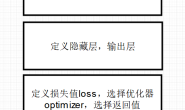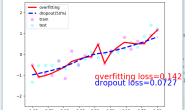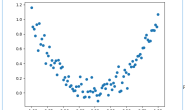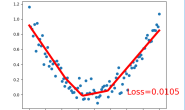tensorflow的RNN(递归神经网络)
运行结果 
 代码如下:
代码如下:
"""
Know more, visit my Python tutorial page: https://morvanzhou.github.io/tutorials/
My Youtube Channel: https://www.youtube.com/user/MorvanZhou
Dependencies:
tensorflow: 1.1.0
matplotlib
numpy
"""
import tensorflow as tf
import numpy as np
import matplotlib.pyplot as plt
# Hyper Parameters
TIME_STEP = 10 # rnn time step
INPUT_SIZE = 1 # rnn input size
CELL_SIZE = 32 # rnn cell size
LR = 0.02 # learning rate
# show data
steps = np.linspace(0, np.pi*2, 100, dtype=np.float32)
x_np = np.sin(steps); y_np = np.cos(steps) # float32 for converting torch FloatTensor
plt.plot(steps, y_np, 'r-', label='target (cos)'); plt.plot(steps, x_np, 'b-', label='input (sin)')
plt.legend(loc='best'); plt.show()
# tensorflow placeholders
tf_x = tf.placeholder(tf.float32, [None, TIME_STEP, INPUT_SIZE]) # shape(batch, 5, 1)
tf_y = tf.placeholder(tf.float32, [None, TIME_STEP, INPUT_SIZE]) # input y
# RNN
rnn_cell = tf.nn.rnn_cell.LSTMCell(num_units=CELL_SIZE)
init_s = rnn_cell.zero_state(batch_size=1, dtype=tf.float32) # very first hidden state
outputs, final_s = tf.nn.dynamic_rnn(
rnn_cell, # cell you have chosen
tf_x, # input
initial_state=init_s, # the initial hidden state
time_major=False, # False: (batch, time step, input); True: (time step, batch, input)
)
outs2D = tf.reshape(outputs, [-1, CELL_SIZE]) # reshape 3D output to 2D for fully connected layer
net_outs2D = tf.layers.dense(outs2D, INPUT_SIZE)
outs = tf.reshape(net_outs2D, [-1, TIME_STEP, INPUT_SIZE]) # reshape back to 3D
loss = tf.losses.mean_squared_error(labels=tf_y, predictions=outs) # compute cost
train_op = tf.train.AdamOptimizer(LR).minimize(loss)
sess = tf.Session()
sess.run(tf.global_variables_initializer()) # initialize var in graph
plt.figure(1, figsize=(12, 5)); plt.ion() # continuously plot
for step in range(60):
start, end = step * np.pi, (step+1)*np.pi # time range
# use sin predicts cos
steps = np.linspace(start, end, TIME_STEP)
x = np.sin(steps)[np.newaxis, :, np.newaxis] # shape (batch, time_step, input_size)
y = np.cos(steps)[np.newaxis, :, np.newaxis]
if 'final_s_' not in globals(): # first state, no any hidden state
feed_dict = {tf_x: x, tf_y: y}
else: # has hidden state, so pass it to rnn
feed_dict = {tf_x: x, tf_y: y, init_s: final_s_}
_, pred_, final_s_ = sess.run([train_op, outs, final_s], feed_dict) # train
# plotting
plt.plot(steps, y.flatten(), 'r-'); plt.plot(steps, pred_.flatten(), 'b-')
plt.ylim((-1.2, 1.2)); plt.draw(); plt.pause(0.05)
plt.ioff(); plt.show()






